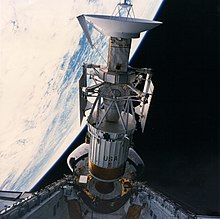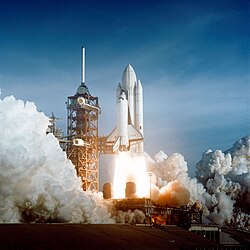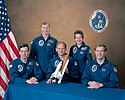STS-30
| Missionsemblem | |||
|---|---|---|---|
 | |||
| Missionsdaten | |||
| Mission | STS-30 | ||
| NSSDCA ID | 1989-033A | ||
| Besatzung | 5 | ||
| Start | 4. Mai 1989, 18:46:59 UTC | ||
| Startplatz | Kennedy Space Center, LC-39B | ||
| Landung | 8. Mai 1989, 19:43:27 UTC | ||
| Landeplatz | Edwards Air Force Base, Bahn 22 | ||
| Flugdauer | 4d 0h 56m 28s | ||
| Erdumkreisungen | 65 | ||
| Bahnhöhe | 341 km | ||
| Bahnneigung | 28,8° | ||
| Zurückgelegte Strecke | 2,7 Mio. km | ||
| Nutzlast | Magellan | ||
| Mannschaftsfoto | |||
 v. l. n. r. Ronald Grabe, David Walker, Norman Thagard, Mary Cleave, Mark Lee | |||
| ◄ Vorher / nachher ► | |||
| |||
STS-30 (englisch Space Transportation System) ist eine Missionsbezeichnung für das US-amerikanische Space Shuttle Atlantis (OV-104) der NASA. Der Start erfolgte am 4. Mai 1989. Es war die 29. Space-Shuttle-Mission und der 4. Flug der Raumfähre Atlantis. Hauptziel der Mission war es, die Venussonde Magellan auszusetzen.
Mannschaft
- David Walker (2. Raumflug), Kommandant
- Ronald Grabe (2. Raumflug), Pilot
- Norman Thagard (3. Raumflug), Missionsspezialist
- Mary Cleave (2. Raumflug), Missionsspezialistin
- Mark Lee (1. Raumflug), Missionsspezialist
Missionsüberblick

Ein erster Startversuch am 28. April wurde bei T-31 Sekunden gestoppt, weil Probleme mit dem Flüssigwasserstoffkreislauf zwischen externem Tank und Shuttle auftraten. Am eigentlichen Starttag verzögerte starker Wind am Notlandeplatz in Cape Canaveral den Countdown um eine knappe Stunde.
Die Venussonde Magellan mit einer IUS Oberstufe wurde kurz nach dem Shuttlestart planmäßig ausgesetzt. Im weiteren Verlauf der Mission musste einer der fünf Hauptcomputer im Orbit ausgetauscht werden. STS-30 war die erste Mission, bei der das Space Shuttle dazu genutzt wurde, eine interplanetare Raumsonde zu starten.
Die Landung erfolgte am 8. Mai in Edwards AFB, Kalifornien. Atlantis wurde 7 Tage später mittels eines Spezialflugzeuges nach Cape Canaveral, Florida zurücktransportiert.
Siehe auch
Weblinks
- NASA-Missionsüberblick (englisch)
- Videozusammenfassung mit Kommentaren der Besatzung (englisch)
- STS-30 in der Encyclopedia Astronautica (englisch)
Auf dieser Seite verwendete Medien
The April 12 launch at Pad 39A of STS-1, just seconds past 7 a.m., carries astronauts John Young and Robert Crippen into an Earth orbital mission scheduled to last for 54 hours, ending with unpowered landing at Edwards Air Force Base in California.
Five astronauts composed the STS-30 crew. Pictured (left to right) are Ronald J. Grabe, pilot; David M. Walker, commander; and mission specialists Norman E. Thagard, Mary L. Cleave, and Mark C. Lee. The STS-30 mission launched aboard the Space Shuttle Atlantis on May 4, 1989 at 2:46:59pm (EDT). The primary payload was the Magellan/Venus Radar mapper spacecraft and attached Inertial Upper Stage (IUS).
Magellan being deployed with IUS stage during the STS 30 (Atlantis) flight.
The STS-30 patch depicts the joining of NASA's manned and unmanned space programs. The sun and inner planets of our solar system are shown with the curve connecting Earth and Venus symbolizing the shuttle orbit, the spacecraft trajectory toward Venus, and its subsequent orbit around our sister planet. A Spanish caravel similar to the ship on the official Magellan program logo commemorates the 16th century explorer's journey and his legacy of adventure and discovery. Seven stars on the patch honor the crew of Challenger. The five-star cluster in the shape of the constellation Cassiopeia represent the five STS-30 crewmembers - Astronauts David Walker, Ronald Grabe, Norman Thagard, Mary Cleave and Mark Lee - who collectively designed the patch.




